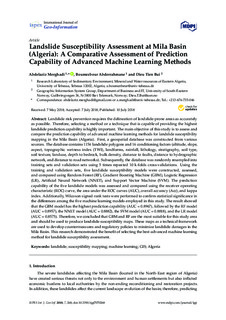| dc.description.abstract | Landslide risk prevention requires the delineation of landslide-prone areas as accurately as possible. Therefore, selecting a method or a technique that is capable of providing the highest landslide prediction capability is highly important. The main objective of this study is to assess and compare the prediction capability of advanced machine learning methods for landslide susceptibility mapping in the Mila Basin (Algeria). First, a geospatial database was constructed from various sources. The database contains 1156 landslide polygons and 16 conditioning factors (altitude, slope, aspect, topographic wetness index (TWI), landforms, rainfall, lithology, stratigraphy, soil type, soil texture, landuse, depth to bedrock, bulk density, distance to faults, distance to hydrographic network, and distance to road networks). Subsequently, the database was randomly resampled into training sets and validation sets using 5 times repeated 10 k-folds cross-validations. Using the training and validation sets, five landslide susceptibility models were constructed, assessed, and compared using Random Forest (RF), Gradient Boosting Machine (GBM), Logistic Regression (LR), Artificial Neural Network (NNET), and Support Vector Machine (SVM). The prediction capability of the five landslide models was assessed and compared using the receiver operating characteristic (ROC) curve, the area under the ROC curves (AUC), overall accuracy (Acc), and kappa index. Additionally, Wilcoxon signed-rank tests were performed to confirm statistical significance in the differences among the five machine learning models employed in this study. The result showed that the GBM model has the highest prediction capability (AUC = 0.8967), followed by the RF model (AUC = 0.8957), the NNET model (AUC = 0.8882), the SVM model (AUC = 0.8818), and the LR model (AUC = 0.8575). Therefore, we concluded that GBM and RF are the most suitable for this study area and should be used to produce landslide susceptibility maps. These maps as a technical framework are used to develop countermeasures and regulatory policies to minimize landslide damages in the Mila Basin. This research demonstrated the benefit of selecting the best-advanced machine learning method for landslide susceptibility assessment. | nb_NO |

